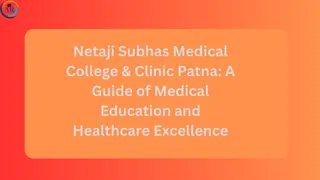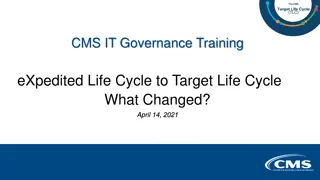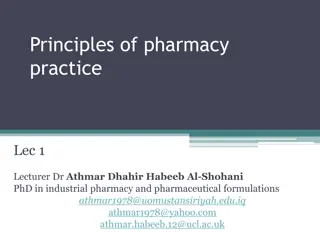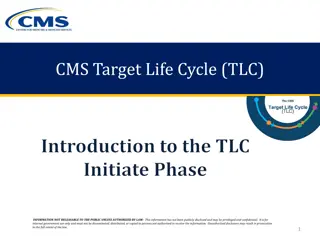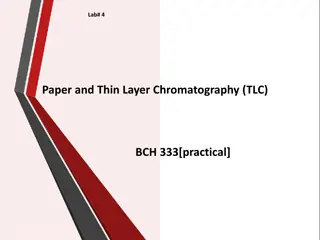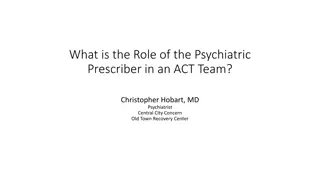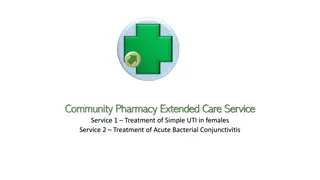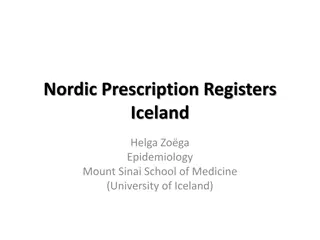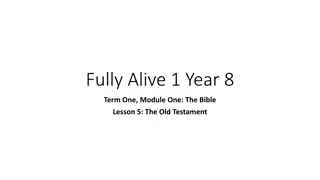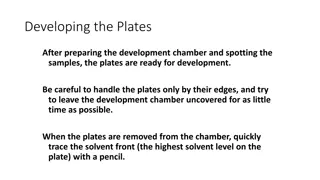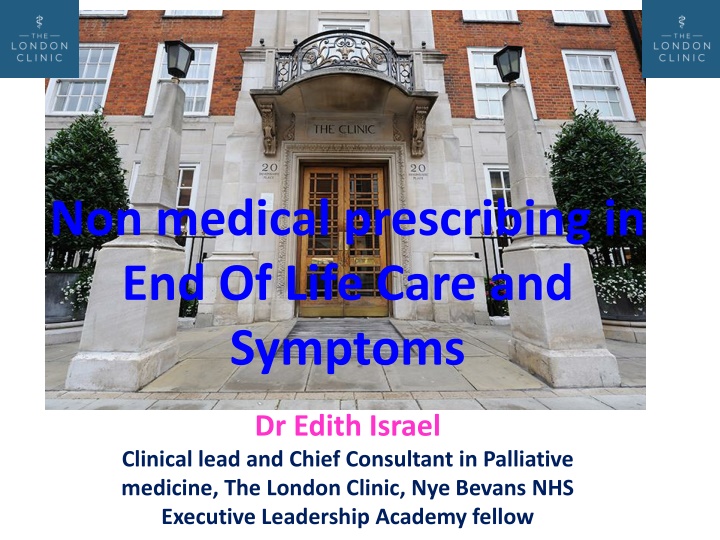
End of Life Care: Non-Medical Prescribing and Patient Identification
Explore the role of non-medical prescribing in end-of-life care, understand the criteria for identifying end-of-life patients, and learn about the different scenarios that define patients in this category. Discover the importance of empowering nurses to prescribe for symptom control and managing pain effectively in end-of-life situations.
Download Presentation

Please find below an Image/Link to download the presentation.
The content on the website is provided AS IS for your information and personal use only. It may not be sold, licensed, or shared on other websites without obtaining consent from the author. If you encounter any issues during the download, it is possible that the publisher has removed the file from their server.
You are allowed to download the files provided on this website for personal or commercial use, subject to the condition that they are used lawfully. All files are the property of their respective owners.
The content on the website is provided AS IS for your information and personal use only. It may not be sold, licensed, or shared on other websites without obtaining consent from the author.
E N D
Presentation Transcript
Non medical prescribing in End Of Life Care and Symptoms Dr Edith Israel Clinical lead and Chief Consultant in Palliative medicine, The London Clinic, Nye Bevans NHS Executive Leadership Academy fellow
Objectives Nurse prescribing for symptom control: current issues Empowering nurses to prescribe in end of life care Managing pain at the end of life Controlled drugs and non medical/nurse prescribing The use of drugs beyond their medical licence Improving non medical prescribing practice at the end of life
Which one of these patients is an EOL patient? Image result for young colorectal cancer patients Image result for cystic fibrosis 18 y.o Erika Morales Feisty teenager, loves surfing Cystic fibrosis Well known to Royal Brompton Hosp (RBH) Been in & out RBH most of 2017 Liver failure + resistant infections Jehovah s witness (not for transplant) 82 y.o. Maevis Bell NH Resident Dementia 5yrs ago Quite happy Son + daughter visit regularly - Recurrent hospital admissions infections, falls, UTI, aspiration LRTI - Now barely E +D 47 y.o John Shepherd - accountant Father of 2 Metastatic colorectal cancer since 2011 Now awaiting immunotherapy trial at Royal Marsden
Who is considered to be an EoL Patient? Patients who are approaching the end of life, are likely to die in the next 6- 12 months National definition & CQC definitionhttps://www.nhs.uk/conditions/end-of-life- care/what-it-involves-and-when-it-starts/
Who is considered to be an EoL Patient? This includes people whose death is imminent, as well as people who: have an advanced incurable illness, such as cancer, dementia or motor neurone disease are generally frail and have co-existing conditions that mean they are expected to die within 12 months have existing conditions if they are at risk of dying from a sudden crisis in their condition have a life-threatening acute condition caused by a sudden catastrophic event, such as an accident or stroke National definition & CQC definitionhttps://www.nhs.uk/conditions/end-of-life-care/what-it-involves-and-when-it-starts/
Would you be surprised if the patient were to die in the next 6-12 months?
Controlled drugs in End of Life and use of drugs beyond product license Frequently used controlled drugs used at end of life include: Morphine, Oxycodone, Fentanyl, Alfentanyl, Diamorphine, Midazolam Others of note: Pregabalin, Methadone, Ketamine NB: Medicinal cannabis specialist register Legal aspects of prescribing unlicensed medications Prescribing off-label
Principles of N-MP post Shipman/Gosport report Hand writing requirements Signature on collection of CD prescriptions Registers /record keeping requirements 30 day supply 28 day validity Government response to the recommendations of the Shipman Inquiry's fifth report and to the Ayling, Neale and Kerr/Haslam inquiries - GOV.UK (www.gov.uk) 19/03/2025
Principles of N-MP post Shipman/Gosport report Accountable Office Role: Information Sharing & co-operation between bodies Inspection Monitoring prescribing of CDs Requirement to report incidents to AO Sharing lessons learnt 19/03/2025
Principles of N-MP post Shipman/Gosport report REPORTING INCIDENTS, NEAR MISSES AND CONCERNS INVOLVING CDs Record Keeping and Stock Discrepancies Clinical Governance and Professional Practice Fraud & Possible Criminal Issues 19/03/2025
Principles of N-MP post Shipman/Gosport report Controlled Drugs Accountable Officer s national update (22 September 2020) - Watch this video on Vimeo: https://vimeo.com/464953934 This is a good video if you have time to view it, that addresses governance in health and social care it is the controlled drugs accountable officers annual update ( Sept 20), the AA is also a pharmacist and lawyer. Start the video from minute 2 to avoid usual teams meeting gaffs 19/03/2025
Issues for Non Medical Prescribers Royal College of Pharmaceutical competencies Role and remit Competency Job description/professional indemnity Local policies/formulary Legal & best practice requirements The patient/patient group 19/03/2025
Issues for Non Medical Prescribers Newly qualified NMPs Off licence drug Confidence, pressure, family pressure to prescribe/or not Specialist initiated treatment protocols Difficult to manage symptoms 19/03/2025
Mixing medicines that include controlled drugs National guideline Care of Dying Adult, NICE 2016, Local guidelines Regular v PRN v Syringe Driver Combining medicines in a syringe driver/Recognition of incompatibility Only prescribes medicines that are unlicensed, off-label , or outside standard practice if satisfied that an alternative licensed medicine would not meet the patient's clinical needs. 14
The use of anticipatory prescribing 1) ASSESS PATIENT & symptoms Document findings & clear decision making process 2) CONSIDER OPTIONS risk and benefits 3) REACH A SHARED DECISION work with pt/carer and seniors I.e. consultant in pall care 4) PRESCRIBE risk and benefits, national guideline 5) MONITOR & REVIEW
Pain at the End of Life Is patient currently taking strong opioid? Yes No Assessment Does patient have uncontrolled pain? Is pain controlled on strong opioid? No Yes Yes No ASSESS CAUSE Consider alternative causes of pain including: urinary retention constipation NO If patient cannot take oral meds: Convert regular 24 hour dose of oral opioid to sub-cutaneous (sc) syringe driver Oral-to sc conversion ratio for Morphine and Oxycodone is 2:1 (i.e. to get dose for sc route, divide oral dose by 2) Prescribe prn analgesia 1/6th of 24 hour dose e.g. syringe driver with 30mg morphine over 24 hours equates to 5mg sc morphine prn Transdermal patches (e.g. Fentanyl) should continue PRN analgesia is often Oxycodone in these cases Yes Prescribe regular/prn analgesia as appropriate: Morphine is the usual first-line opioid for patients with pain at the end of life. Caution is advised with the following risk factors: RENAL IMPAIRMENT FRAILTY MORPHINE INTOLERANCE Suggested Treatment Treatment options are: Convert oral dose to sc and reassess Increase dose by 25-50% Switch to alternative opioid Does your patient have any of these risk factors? No Yes Suggestion for regular analgesia: Morphine sulphate 10-15mg over 24 hours sc via syringe driver Suggestion for prn: Morphine sulphate 2.5-5mg sc Suggestion for regular analgesia: Oxycodone 2.5-5mg over 24 hours via syringe driver Suggestion for prn: Oxycodone 1.25mg sc
Watch for Side effects and Toxicity! TOXICITY SIDE EFFECTS 1. Nausea 2. Vomiting 3. Constipation 4. Sedation/drowsiness 5. Vivid dreams 6. Visual hallucinations 7. Myoclonic jerks Coma (reduced GCS) Respiratory depression Pinpoint pupil Myoclonic jerks Visual hallucinations Confusion Treat underlying cause, consider opioid switch/withdrawl, consider naloxone RR Check for precipitant i.e. dehydration, renal failure, infection, drug interactions
Nausea & Vomiting
Approaches to Managing Nausea & Vomiting D2 D2 H1/muscarinic 5HT3 D2/H1/muscarini c/5HT
Respiratory secretions
Respiratory Tract Secretions at the End of Life Present Absent Assessment ASSESS CAUSE Possible causes include: Retained saliva/nasopharyngeal secretions or vomit; Infective secretions, e.g. purulent sputum; Positive fluid balance, e.g. due to excess parenteral fluids or nutrition Infective secretions, e.g. CAP/HAP Saliva and/or retained secretions Retained VOMIT Consider suctioning Consider single dose of broad spectrum IV antibiotic Non-drug management: Positioning Reassurance and explanation of causes for family Avoid suctioning Suggested Treatment Consider a peripherally-acting anti- muscarinic, e.g. Glycopyrronium 0.6-1.2mg over 24 hours sc via syringe driver START REASSESS CAUSE Glycopyrronium/Hyosci ne hydrobromide 0.2- 0.4mg sc prn OR Hyoscine Butylbromide 20mg sc ANTI-EMETIC (see GUIDE)
Agitation and anxiety
End of Life - Terminal Agitation/Restlessness in Adults (Prognosis of hours to days) Absent Present Assessment ASSESS CAUSE Consider treating potentially reversible risk factors where appropriate e.g. urinary retention, constipation, uncontrolled pain, opiate toxicity, known biochemical abnormality, hypoxia, hypoglycaemia, sepsis Once potential reversible factors considered Midazolam 2.5-5mg sc prn +/- Lorazepam 0.5mg -1mg SL Suggested Treatment Midazolam 2.5-5mg sc prn Consider need for syringe driver with Midazolam 5-10mg over 24 hours sc (reduce dose if frail or have renal impairment) Persistent restlessness NOT responding to prn midazolam Persistent restlessness responding to prn midazolam Persistent restlessness NOT responding to prn midazolam REASSESS CAUSE REASSESS CAUSE Increase Midazolam in syringe driver according to prn dosage used in last 24 hours, to a maximum of 30mg over 24 hours If symptoms have not responded to 30mg Midazolam over 24 hours sc then please contact Palliative Care urgently for further advice.
References Department of Health Faculty of pain medicine https://www.gov.uk/government/publications/information-about-controlled- drugs-regulations Care Quality Commission https://www.cqc.org.uk/guidance- providers/controlled-drugs/controlled-drugs NICE 2016 https://www.nice.org.uk/guidance/ng46/evidence/full-guideline- pdf-2427186353 Faculty of pain management http://www.fpm.ac.uk/faculty-of-pain- medicine/opiodaware Royal Pharmaceutical Society (2016) A Competency Framework for all prescribers Schneider & Dickman, A (2016). The syringe Driver, Continuous subcutaneous infusions in palliative care. 4th Edition. Oxford university press. www.nmc.org.uk/standards-profiency-nurse-and-midwife-prescribers
To Take Away (TTA) Image result for how to eat an elephant Practice safe prescribing Practice, practice, practice and document! Since so many people were in the same boat, I appreciated the reminder that eating an elephant can only be done one way: one bite at a time. Trying to gulp it down in one sitting is asking for severe indigestion. We know intellectually that the best way to accomplish something big is to approach it in smaller pieces How to eat an elephant The Introverted Entrepreneur
WHO CAN PRESCRIBE WHAT? Nurse and pharmacist independent prescribing changes announced - GOV.UK (www.gov.uk) This is a really good link to clarify who can prescribe what use the drop down box for independent non medical prescribers 19/03/2025



